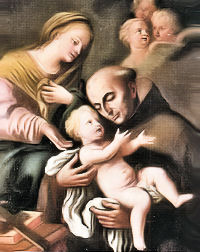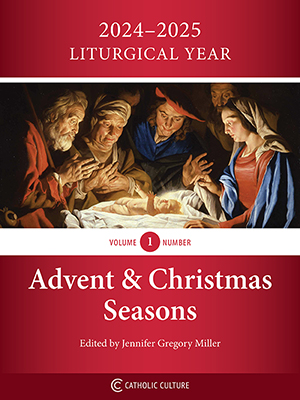Lent: March 5th
Thursday of the First Week of Lent
Other Commemorations: St. Lucius I, Pope and Martyr (RM); St. John Joseph of the Cross, Priest (RM)
» Enjoy our Liturgical Seasons series of e-books!
"Everyone who exalts himself will be humbled, and the one who humbles himself will be exalted." (Lk. 18:14) "Even if we should have mounted to the very pinnacle of virtue, let us consider ourselves last of all; having learned that pride is able to cast down even from the heavens themselves him who takes not heed, and humbleness of mind to bear up on high from the very abyss of sins him who knows how to be sober. For this it was that placed the publican before the Pharisee." — St. John Chrysostom
Meditation- Mary's Acceptance of All, for Love of Us
Mary, there present as eyewitness to the sacred Passion of her divine Son on Good Friday, was destined to be present in spirit and maternal interest at future scenes in the unending tragedy of Christ Jesus' Passion in His members through all the Christian centuries. She was destined to be present precisely in that high office to which Jesus Himself would assign her at the foot of His cross on Calvary, as the Mother of all who live the divine life of the children of the Second Adam. Hence, to fit her for this office of Mediatrix who would have Christ-like compassion on all our human infirmities, she too must be tempted in all things as we are (without sin), that we might with confidence go to the throne of her mercy, there to obtain the precious grace of Christ-like obedience through her who herself learned perfect obedience by the things which she suffered with her divine Son. She also must be tested that, by her union with the very humiliation and suffering with which the Son purchased His title of High Priest, the Mother too might at the same time purchase her title — Mediatrix of all the graces to be dispensed from the treasury of the Sacred Heart of Him, who alone is in His own right the great High Priest, the universal and plenipotentiary Mediator of the New Testament.
Mark well, therefore—it was on Good Friday, during these hours of darkness and shame and anguish which Mary shared with Jesus most intimately, that the Savior fountains of the Second Adam poured their tenderest mercifulness into the heart of the Second Eve so copiously, that until the Book of Life is filled the whole world might with unlimited filial confidence have recourse to Mary—
The Health of the sick,— Our Way to the Father by Rev. Leo M. Krenz, S.J.
The safe Refuge of sinners,
The sympathetic Comforter of the afflicted,
The unfailing Help of Christians
Things to Do:
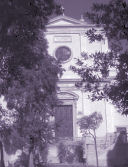
The Station today is at St. Lawrence in Panisperna. The church stands on the site of St. Lawrence's martyrdom. The appellation refers to the name of the street, which in turn most likely refers to the tradition of the Poor Clares in the adjacent convent of distributing bread and ham (pane e perna) on August 10th, the feast day of St. Lawrence. This is done in remembrance of St. Lawrence distributing funds from the church to the poor.
St. Lucius I
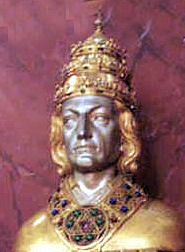 St. Lucius, according to the "Liber Pontificalis," was a Roman, the son of Porphyrius. When he succeeded St. Comelius, the persecution of Trebonianus Gallus was still raging, and the new Pope was exiled. Soon, however, the persecution died away and Lucius was able to return to Rome. There is extant a letter from St. Cyprian congratulating the Pope on his return from exile and praising him for his confession of Christ.
St. Lucius, according to the "Liber Pontificalis," was a Roman, the son of Porphyrius. When he succeeded St. Comelius, the persecution of Trebonianus Gallus was still raging, and the new Pope was exiled. Soon, however, the persecution died away and Lucius was able to return to Rome. There is extant a letter from St. Cyprian congratulating the Pope on his return from exile and praising him for his confession of Christ.
St. Lucius continued the policy of Cornelius in admitting repentant apostates to communion after due penance. St. Cyprian praises him for this.
The Liber Pontificalis attributes to Pope Lucius a decree ordering that two priests and three deacons should live with a bishop that they might be witnesses for him. Duchesne, however, considers this decree apocryphal.
According to the Liber Pontificalis, Pope Lucius was beheaded in the persecution of Valerian. This is almost certainly inaccurate, for Lucius died before the persecution of Valerian broke out. At any rate, St. Lucius died some time in the beginning of March 254, and was buried in the Cemetery of Calixtus. His tombstone has been discovered. The feast of St. Lucius is kept on March 4.
—Excerpted from Popes Through the Ages, by Joseph Brusher
Patronage: Copenhagen, Denmark
Highlights and Things to Do:
- Read more about Pope St. Lucius I:
- Learn more about Novatian and Novatianism at New Advent.
- St. Lucius was buried in a compartment of the papal vault in the catacombs of St. Callistus. His remains were transferred in 821 to St. Cecilia in Travestere, Rome. The sarcophagus that once held St. Lucius' remains is extant in the crypt of Santa Cecilia. It is said that some of his relics were transferred Roskilde, Denmark around 1100, and his head placed in a reliquary bust in the Saint Ansgar cathedral at Roskilde in 1910. There have been some carbon testings of the skull and the authenticity is being questioned.
St. John Joseph of the Cross
Saint John Joseph of the Cross was born on the feast of the Assumption in 1654, on the island of Ischia in the kingdom of Naples. From his childhood he was a model of virtue, and in his sixteenth year he entered the Franciscan Order of the Strict Observance, or Reform of Saint Peter of Alcantara, at Naples. Such was the edification he gave in his Order, that within three years after his profession he was sent to found a monastery in Piedmont. He assisted in its construction himself and established there the most perfect silence and monastic fervor.
One day Saint John Joseph was found in the chapel in ecstasy, raised far above the floor. He won the hearts of all his religious, and became a priest out of obedience to his Superiors. He obtained what seemed to be an inspired knowledge of moral theology, in prayer and silence. He assisted at the death of his dear mother who rejoiced and seemed to live again in his presence, and after he had sung the Mass for the repose of her soul, saw her soul ascend to heaven, to pray thereafter their God face to face.
With his superiors’ permission he established another convent and drew up rules for the Community, which the Holy See confirmed. Afterward he became a master of novices vigilant and filled with gentleness, and of a constantly even disposition. Some time later he was made Provincial of the Province of Naples, erected in the beginning of the 18th century by Clement XI. He labored hard to establish in Italy this branch of his Order, which the Sovereign Pontiff had separated from the same branch in Spain. His ministry brought him many sufferings, especially moral sufferings occasioned by numerous calumnies. Nonetheless, the Saint succeeded in his undertakings, striving to inculcate in his subjects the double spirit of contemplation and penance which Saint Peter of Alcantara had bequeathed to the Franciscans of the Strict Observance. He gave them the example of the most sublime virtues, especially of humility and religious discipline. God rewarded his zeal with numerous gifts in the supernatural order, such as those of prophecy and miracles.
Finally, consumed by labors for the glory of God, he was called to his reward. Stricken with apoplexy, he died an octogenarian in his convent at Naples, March 5, 1734. Countless posthumous miracles confirmed the sanctity and glory of the Saint, and he was canonized in 1839 by Pope Gregory XVI.
—Excerpted from Lives of the Saints for Every Day of the Year, edited by Rev. Hugo Hoever, S.O. Cist., Ph.D.
Patronage: Ischia, Italy; Naples, Italy
Symbols and Representation: Man wearing a Franciscan habit.
Highlights and Things to Do:
- Read more about St. John Joseph:
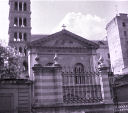
Tuesday of the Third Week of Lent
Station with San Pudenziana al Viminale (St. Pudentiana):
Today's station is in the church of St. Pudentiana, daughter of Pudens the senator. This holy virgin of Rome lived in the second century. She was remarkable for her charity, and for the zeal wherewith she sought for and buried the bodies of the martyrs. Her church is built on the very spot where stood the house in which she lived with her father and her sister St. Praxedes. St. Peter the Apostle had honored this house with his presence, during the lifetime of Pudentiana's grandfather.
For more on San Marco al Campidoglio, see:
For further information on the Station Churches, see The Stational Church.


